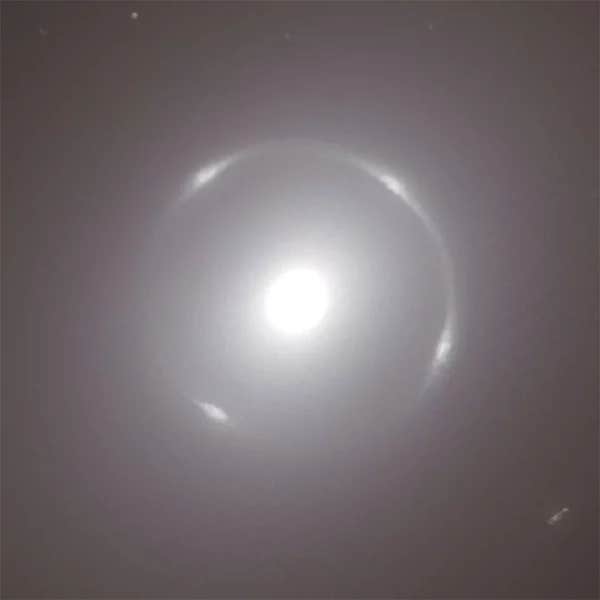Euclid space telescope discovers Einstein Ring in a nearby galaxy
Euclid telescope uncovers an Einstein ring in NGC 6505, revealing insights into dark matter, gravitational lensing, and cosmic evolution.

A close up of the center of galaxy NGC 6505 with the Einstein Ring around it. (CREDIT: ESA / Euclid / Euclid Consortium / NASA, image processing by J.-C. Cuillandre, G. Anselmi, T. Li/European Space Agency)
A recently discovered Einstein ring, nestled within a well-documented galaxy, offers new insights into gravitational lensing and the mysteries of dark matter. Scientists analyzing early images from the Euclid space telescope identified the stunning phenomenon, a perfect ring of distorted light encircling the center of NGC 6505.
This galaxy, located about 590 million light-years from Earth, has been observed for over a century. Yet, its gravitational lens remained undetected until Euclid’s high-resolution imaging capabilities brought it to light. The discovery highlights how much remains hidden, even in familiar parts of the cosmos.
The Einstein ring results from strong gravitational lensing, a process where the immense gravity of a foreground galaxy warps and magnifies the light from a more distant source. The background galaxy in this case is an astonishing 4.42 billion light-years away. The precise alignment of these celestial objects created a striking ring—one of the most visually perfect ever recorded.
The Science of Gravitational Lensing
Albert Einstein’s general theory of relativity predicted that massive objects bend the fabric of spacetime, causing light to follow curved paths. This effect, known as gravitational lensing, allows astronomers to see distant galaxies otherwise obscured from view.
In some cases, gravitational lensing creates multiple images of a background object. When the alignment is nearly perfect, the bending light forms a full ring around the foreground galaxy—an Einstein ring. These phenomena provide unique opportunities to study the large-scale structure of the universe, the nature of dark matter, and the fundamental properties of space-time.
“An Einstein ring is an example of strong gravitational lensing,” explains Conor O’Riordan of the Max Planck Institute for Astrophysics. “All strong lenses are special because they're so rare, and they're incredibly useful scientifically. This one is particularly special, because it’s so close to Earth and the alignment makes it very beautiful.”
Strong lenses serve as natural cosmic magnifiers, allowing scientists to observe faint, distant galaxies in greater detail. They also help measure cosmic distances and refine estimates of the Hubble constant, which describes the rate of the universe’s expansion.
Weak gravitational lensing, a subtler version of this effect, slightly distorts the images of background galaxies without producing full rings. Analyzing these distortions across billions of galaxies helps astronomers map the distribution of dark matter, an invisible substance that makes up most of the universe’s mass.
Related Stories
Euclid’s Mission to Map the Dark Universe
Euclid launched on July 1, 2023, embarking on a six-year mission to explore the large-scale structure of the universe. Designed to study the effects of dark energy and dark matter, the telescope is mapping more than a third of the sky, imaging billions of galaxies up to 10 billion light-years away.
By detecting and analyzing strong gravitational lenses, Euclid is expected to identify over 100,000 new lensing systems—an unprecedented expansion of the known catalog. Until recently, fewer than 1,000 strong lenses had been documented, and even fewer had been imaged in such high resolution.
The discovery of the Einstein ring around NGC 6505 came during an early testing phase of Euclid’s instruments in September 2023. Scientists were calibrating the telescope when they noticed an unusual pattern in one of the images.
“I look at the data from Euclid as it comes in,” says Euclid Archive Scientist Bruno Altieri. “Even from that first observation, I could see it, but after Euclid made more observations of the area, we could see a perfect Einstein ring. For me, with a lifelong interest in gravitational lensing, that was amazing.”
Valeria Pettorino, ESA Euclid Project Scientist, was equally impressed by the find. “I find it very intriguing that this ring was observed within a well-known galaxy, which was first discovered in 1884. The galaxy has been known to astronomers for a very long time. And yet this ring was never observed before. This demonstrates how powerful Euclid is, finding new things even in places we thought we knew well.”
Unlocking the Secrets of Dark Matter
One of the most important applications of gravitational lensing is its ability to probe dark matter. Since dark matter does not emit or absorb light, it cannot be observed directly. However, its gravitational influence distorts and bends the light from distant galaxies.
By analyzing these distortions, astronomers can map the invisible mass surrounding galaxies and determine its distribution. Precise modeling of lensed images helps test different theories of dark matter and refine our understanding of its role in the universe’s evolution.
Strong gravitational lenses also allow researchers to separate dark matter from ordinary stellar mass within galaxies. Studies suggest that early-type galaxies, like NGC 6505, have dense inner regions dominated by stars with more massive compositions than those in galaxies like the Milky Way. These findings support theories that galaxies undergo a two-phase evolution, with their inner cores forming early and their outer regions accreting material over time.
The Einstein ring around NGC 6505 provides an excellent case study for testing these theories. Since the mass within the ring is primarily stellar, measuring the mass distribution within the lensing galaxy will help refine models of its composition and structure.
As Euclid continues its sky survey, the telescope is poised to uncover thousands more gravitational lenses. These discoveries will further our understanding of the fundamental forces shaping the cosmos.
“Euclid is going to revolutionize the field, with all this data we've never had before,” O’Riordan adds.
Although this Einstein ring is a remarkable find, Euclid’s primary goal is detecting the more subtle effects of weak gravitational lensing. By precisely measuring these distortions across billions of galaxies, scientists hope to construct the most detailed 3D map of the universe yet.
The mission’s early results confirm that Euclid is on course to achieve its ambitious objectives. If this discovery is any indication, the telescope will continue to reveal hidden cosmic structures, transforming our understanding of the universe’s past, present, and future.
Note: Materials provided above by The Brighter Side of News. Content may be edited for style and length.
Like these kind of feel good stories? Get The Brighter Side of News' newsletter.
Joseph Shavit
Head Science News Writer | Communicating Innovation & Discovery
Based in Los Angeles, Joseph Shavit is an accomplished science journalist, head science news writer and co-founder at The Brighter Side of News, where he translates cutting-edge discoveries into compelling stories for a broad audience. With a strong background spanning science, business, product management, media leadership, and entrepreneurship, Joseph brings a unique perspective to science communication. His expertise allows him to uncover the intersection of technological advancements and market potential, shedding light on how groundbreaking research evolves into transformative products and industries.



